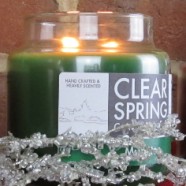What’s in a wax? A closer look at a candle’s main ingredient
If we were launching a new line of candles a couple thousand years ago, around the time when candles were invented, our ads might say “Check out our new line of whale fat candles!” or “Enjoy the warm glow of tallow!” (Tallow is beef or mutton fat.) But thankfully, much progress has been made over the centuries when it comes to the base ingredients we use in candlemaking. Today, consumers have a wide array of options, with paraffin and soy being two of the most popular. As consumers often approach us with questions about the differences between these and other types of wax, we thought it may be helpful to give an overview of some common waxes. Paraffin Wax is one of the most commonly poured candle waxes today. Paraffin is a byproduct of the crude oil refinement process. For that reason, it often gets a bad rap, and is frowned upon by some who scoff at the idea of burning such a substance. However, if made correctly, paraffin candles burn cleanly and beautifully. It’s also important to note that because paraffin is a byproduct, candles provide a use for something that would otherwise be discarded. Soy Wax is made from soybeans and/or soybean oil. Some “soy blends” may include other all-natural ingredients such as coconut oil, palm wax or beeswax. I’m often asked if soy candles are soot-free. Though they’re sometimes marketed as such, this is misleading – as soot is always produced as a result of the combustion process when a carbon-based substance is burned. If made improperly, such as with the wrong wick or with too much fragrance oil, soy candles can give off as much or more soot than other types of candles. Palm Wax is an all-natural wax derived from palm oil. It’s characterized by the attractive crystalline look it creates after the wax hardens in a candle mold or container. Beeswax is, as its name would suggest, a yellow-to-golden colored wax produced by honeybees, which use it to incubate their larvae within honeycombs. Straight beeswax typically smells sweet like honey, and is a harder wax with a higher melting point. It can also be used as an additive to harden paraffin wax. Beeswax is known for a cleaner burn than many other waxes. Not to get all scientific on you, but most wax types come in a variety of melting points. Wax with a lower melting point is commonly used in container candles, as it’s typically soft and adheres well to the side of a jar. Pillars and votives are often made with wax of a higher melting point, which is usually harder and, as such, tends to shrink more upon cooling. That can help candles release easier from molds. Knowing more about these common waxes will help you choose the candles that are right for...
Read MoreWhy it’s important to “dip that wick”
So you notice that jar candle up on the mantle has a pretty deep pool of melted wax and you think to yourself, “It’s time to blow that out.” But before you do, read on – as there’s a better way to go about it! Not to get all science-y on you, but you’ve probably noticed that when you blow out a candle, it smokes – sometimes a lot. That’s because the core of the wick continues to burn for a short time. In that time, the inside of the wick can turn to carbon (ash), making it quite brittle and the candle hard to light the next time. Then there’s the smell. After allowing a fragrant candle to burn for a couple hours, why wipe out all that beautiful scent with the smell of smoke? And all that icky soot. People often say, “Wow, that candle is burning really sooty!” But in fact, much of the gray or black soot buildup seen on the glass jar is caused by the smoke that billows when the candle is blown out. It can be dangerous, too. In the case of a pillar candle, you could accidentally blow some of the melted wax right off of the candle. So what to do? It’s quite simple: dip that wick! Many retailers sell ‘wick dippers,’ with some of them being quite ornate and expensive. However, you can use anything from tweezers to a knife to a popsicle stick. (Just be careful if the object is flammable, such as a popsicle stick.) After you extinguish the candle, prop up the wick, pulling it out of the wax so it’s ready to light next time. So unless you’re blowing out the candles on a birthday cake, find something around the house to use as a wick dipper, and the air in your home will be cleaner – and your candles will be,...
Read MoreRemember: Your candle has a memory
Even though candles don’t have brains, they do have memory. Confused? I’ll explain… Have you ever lit a jar candle, only to blow it out a half-hour later as you leave the house? Chances are the melt pool – the area of melted wax – never reached the side of the container. While this may not seem like a big deal at the time, it can lead to some wasted wax down the road. That’s because the next time you light the candle, it will be inclined to “tunnel” (burn a hole down the middle) rather than form a melt pool all the way to the edges. That’s what we mean when we say a candle has a ‘memory.’ A narrower melt pool will also cause a scented candle to emit less fragrance than it would otherwise. How to help a candle’s ‘memory’ A good rule of thumb is to make sure you burn the candle long enough for the melt pool to reach the edges of the container. Often this means leaving the candle lit for one hour for every inch of the candle’s diameter. But be careful not to burn a candle too long at one time, as that could cause problems, such as too big of a melt pool, an overheated jar at risk of cracking, etc. For a pillar candle, it should be allowed to burn long enough that the melt pool extends toward the edges, as the candle burns down on itself. And if it’s still not reaching the edge? If you burn a candle for this long and its melt pool is still far from reaching the edges or the flame looks unusually small, the candle may be “under-wicked” (made with too small of a wick) or the wick may be clogged. Another possibility is that the wick was trimmed too short after the last time it was burned. If it’s a trimming problem, try clearing out a bit of the wax around the wick before lighting it – as that should allow the flame to get big enough so as to form a wider melt pool than it would otherwise. Buying the right candle It’s important to buy a candle that will consistently form an “edge to edge” melt pool of wax when burned properly. Otherwise, you’ll find that much of the wax in the candle for which you paid good money will go to waste. Put another way, if you buy a candle with an expected burn time of 80 hours but a quarter of that wax never burns, that cuts 20 hours from the overall burn...
Read MoreThe top four reasons to buy candles as gifts on this Cyber Monday
4) She doesn’t have the heart to tell you, but Aunt Millie really doesn’t need another scarf. 3) The fruitcake you made last year resulted in the hospitalization of three family members. 2) “Here, light this candle” is a kinder, gentler way of saying “Your house smells weird.” And the #1 reason that our candles make for great holiday gifts… 1) They make a home smell wonderful, look great and feel cozy! Ready to shop? Head to our online store...
Read MoreWelcome to ‘Making Scents!’
This blog is a community to learn about and discuss “all things candles.” If you’re like many of our customers, you enjoy a wide range of candles and you’re always looking for the latest tips and trends on how to burn candles. Our goal is to provide a forum for such information – and a place where you can get your candle-related questions answered. Please feel free to post comments on any of our blog posts. Did we leave one of your questions unanswered? Tell us! I’d like to use this first blog post to introduce our brand new website, which features a dynamic layout and includes a fully-functioning and secure shopping cart. Among the key features are: A homepage designed to help you easily navigate the entire site, and stay informed on our featured specials. Detailed information about all of our products, including container candles, soy candles and our brand new line of tarts. Guides to explain how you can order our products for special occasions, such as wedding and shower favors, and how we can help your group conduct a lucrative fundraiser. Please take some time to click around our new website, and as always, drop us a line with any questions or comments....
Read More



